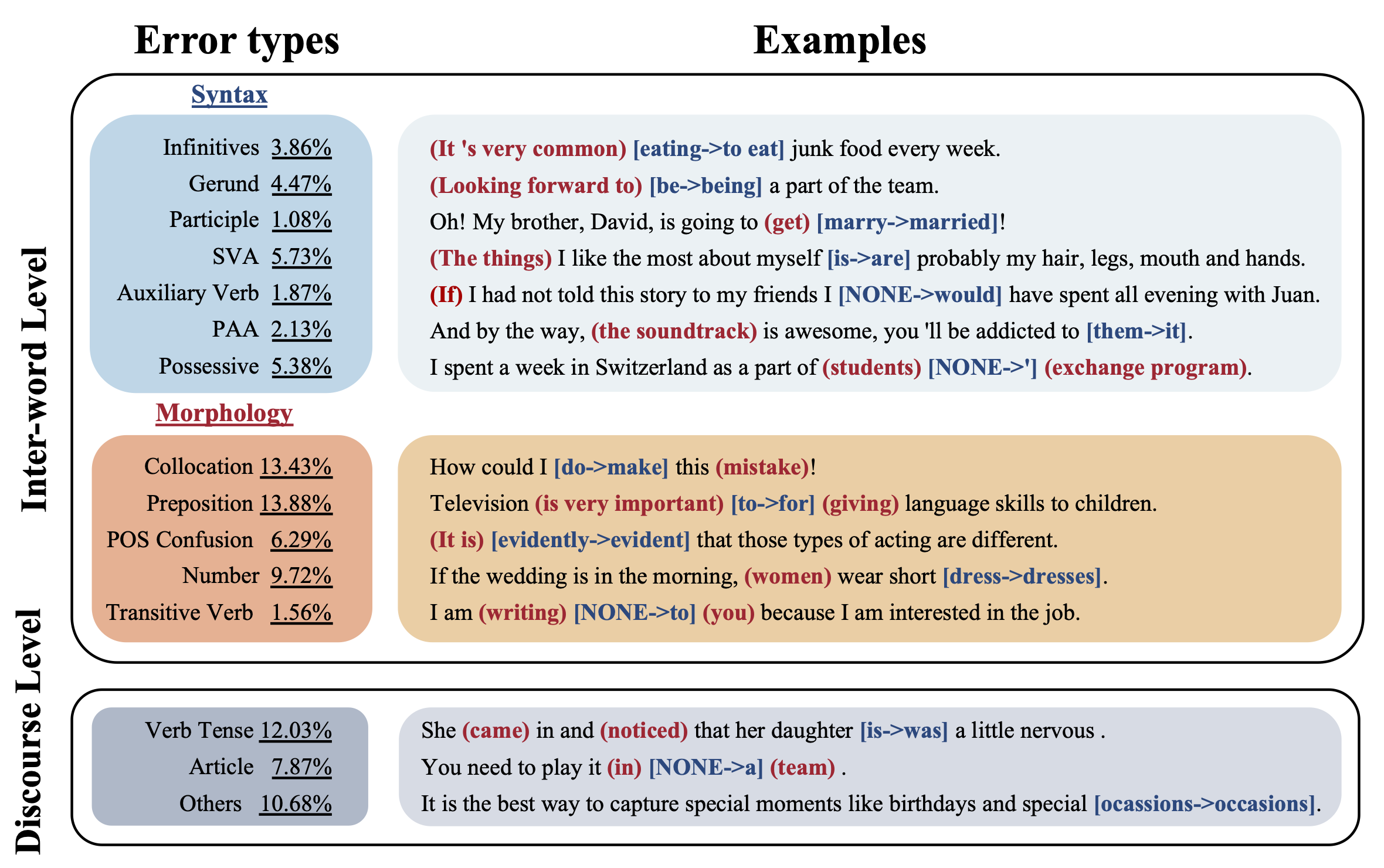This repository provides the dataset and code for the explainable grammmar error correction task as reported in this paper:
Enhancing Grammatical Error Correction Systems with Explanations
Yuejiao Fei∗, Leyang Cui†, Sen Yang, Wai Lam, Zhenzhong Lan, Shuming Shi
2023 The 61st Annual Meeting of the Association for Computational Linguistics(ACL)(Oral)(PDF)
To help language learners understand why the Grammmar Error Correction system makes a certain correction, we present EXPECT, a large dataset with evidence words and grammatical error types labeled.
We also put forward several robust benchmarks for this task.
Examples of each error type and corresponding evidence words in EXPECT.
| Train | Dev | Test | Outputs | |
|---|---|---|---|---|
| Number of sentences | 15,187 | 2,413 | 2,416 | 1001 |
| Number of words | 435,503 | 70,111 | 70,619 | 27,262 |
| Avg. w.p.s | 28.68 | 29.06 | 29.23 | 27.23 |
| With evidence rate | 74.15 | 59.10 | 59.77 | 72.73 |
| Total evidence words | 29,187 | 4,280 | 4,340 | 1736 |
| Avg. evidence w.p.s | 2.59 | 3.00 | 3.01 | 2.38 |
data/json/train.json is the training set. data/json/dev.json and data/json/test.json are the dev set and test set, which are splited from the dev set of W&I+LOCNESS.
The format of the samples is shown below:
{
"target": ["It", "has", "a", "high", "-", "density", "population", "because", "of", "its", "small", "territory", "."],
"source": ["It", "has", "a", "high", "-", "density", "population", "because", "[NONE]", "its", "small", "territory", "."],
"correction_index": [8, 22],
"evidence_index": [7, 9, 10, 11, 21, 23, 24, 25],
"error_type": "Preposition",
"predicted_parsing_order": {"1": 3, "5": 2, "7": 2, "8": 1, "9": 3, "10": 2, "15": 3, "19": 2, "21": 2, "22": 1, "23": 3, "24": 2},
"origin": "A"
}"target"is the corrected sentence, with the corrected words indexed with"correction_index"."source"is the erroneous sentence, with the erroneous words also indexed with"correction_index"."correction_index"is the index of corrected and erroneous words, where the target and source sentences are concatenated with a separation token in between."evidence_index"is the index of evidence words for both the target and source sentences, where the target and source sentences are concatenated with a separation token in between."error_type"is the class of the error type."predicted_parsing_order"represents first-order dependent words (Number 2) and second-order dependent words (Number 3) in the dependency parse tree. Number 1 represents the position of the corrections."origin"is the learner's CEFR proficiency, which corresponds to W&I+LOCNESS.
We provide a script for processing the raw data into NER input format. Specify data_file and save_file in read_jsonl.py .
python read_jsonl.py --data_file data/json/test.json --save_file data/ner/train.pklAnd use the processed data as the input of the model.
- To train and evaluate Labeling-based Error+Correction model
python run.py cfgs/train_error_correction.py
python run.py cfgs/eval_error_correction.py
- To train and evaluate Labeling-based Error+Correction+CE model
python run.py cfgs/train_error_correction_ce.py
python run.py cfgs/eval_error_correction_ce.py
- To train and evaluate Labeling-based Error+Correction+CE+Syntax model
python run.py cfgs/train_error_correction_ce_syntax.py
python run.py cfgs/eval_error_correction_ce_syntax.py
This dataset is released under the MIT License.
If you use this dataset in your research, please cite it as follows:
@inproceedings{fei-cui-2023-enhancing,
title = "Enhancing Grammatical Error Correction Systems with Explanations",
author = “Fei, Yuejiao and
Cui, Leyang and
Yang, Sen and
Lam, Wai and
Lan, Zhenzhong and
Shi, Shuming”,
month = jul,
year = "2023”,
address = “Toronto, Canada”,
publisher = "Association for Computational Linguistics",
}
